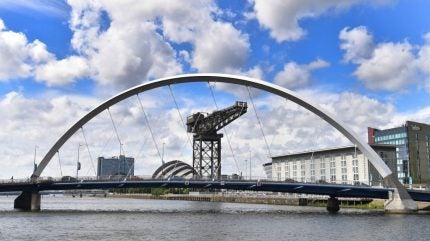
Scotland forms part of the UK but very much has its own identity and culture. This has meant that over the past few decades, a strong independence movement has grown, fired up by the Scottish National Party. A referendum on independence was held in 2014, with the final result being 55% in favour of remaining in the UK and 45% against. A big debate in the run-up to the poll (and after) was whether Scotland could afford independence. Whether part of the UK or not, Scotland hosts some major European cities, renowned for their culture, manufacturing, football, video games and various other industries.
The five largest cities in Scotland are Glasgow, Edinburgh, Aberdeen, Dundee and Paisley. Here we profile each of them and look at the sectors in which they excel.
1. Glasgow
Population: 632,400
The largest city in Scotland, Glasgow has emerged from a period of post-industrial decline at the end of the 20th century and is now a force in advanced manufacturing, technology and culture. It metropolitan population is around 1.8 million, making up more than one-quarter of the total in Scotland. Glasgow hosts three highly regarded universities – the University of Glasgow, the University of Strathclyde and Glasgow Caledonian University – and it holds the highest rate in the UK for retaining its graduates. It hosted the Commonwealth Games in 2014 and was made a Unesco City of Music in 2008. Manufacturing in general, and shipbuilding in particular, continues to be a key strength in Glasgow, while financial and business services, communications, biosciences, creative industries, healthcare, higher education, retail and tourism have become more prominent in the city’s economy over the past few decades. In November 2021, Glasgow hosted the UN’s COP26 event, which saw Scotland play a key role in the global drive to a low-carbon future, green energy and other ESG-related activities.
2. Edinburgh
Population: 506,500
The capital city of Scotland, Edinburgh is a major tourism and culture destination within the UK as well as the location of some of the country’s most highly regarded universities, among them Heriot-Watt University, the University of Edinburgh, Edinburgh Napier University, Queen Margaret University and the Royal College of Surgeons. It is also a major European financial services centre, hosting the headquarters of big global players such as RBS and TSB. Its public sector operations employ a large number of people, while Edinburgh is also a major UK retail haven. Other sectors that thrive in Edinburgh are technology, software and gaming, publishing and printing, and brewing. Its metropolitan population is just over 900,000. The Edinburgh Festival, held every August, is widely considered to be one of the most important such events on a global level.
3. Aberdeen
Population: 198,500
On the north-east coast of Scotland, Aberdeen may be known as the ‘Granite City’, but over the past 50 years has emerged as a European leader in the oil and gas industry. Its metropolitan population is 490,000. Before the discovery of abundant fossil fuels in the North Sea just off Aberdeen’s coast, its economy had been based around fisheries, shipbuilding, textiles and papermaking. Since the 1970s, however, when the oil and gas money started rolling in, Aberdeen has been considered one of the UK’s wealthiest cities. This has enabled Aberdeen to stay ahead of the curve when it comes to all things high-tech, and as the city moves further away from the fossil fuel industry as the world looks to diversity its energy supply, it is also at the forefront of the UK’s renewable energy industry, particularly hydrogen and wind power. Other areas of strength in Aberdeen’s industrial output are agriculture, deep-sea fishing, life sciences, retail, real estate and, increasingly, tourism. Aberdeen has a good reputation for providing highly qualified graduates from its higher education establishments: the University of Aberdeen and Robert Gordon University.
4. Dundee
Population: 148,000
Jam, jute and journalism. These are the ‘three Js’ that Dundee’s economy was built around during its key growth years in the 1800s and 1900s. There is little evidence of the former two in the 2020s, however, although popular children’s comics the Beano and the Dandy are still published from the city. Dundee, on Scotland’s east coast some 90km north of Edinburgh, has had to adapt its economy in the post-war years, and has done so with some success. It was made an official Unesco City of Design in 2014, and the city has cultivated a strong reputation for the development of video games. Tourism is a growing industry in Dundee, with its rejuvenated waterfront a particularly popular attraction. It is also a growing force in manufacturing, biotechnology, green energy (particularly hydrogen), retail and high-tech industries. Dundee’s metropolitan population is 265,000.
5. Paisley
Population: 77,300
Paisley in Renfrewshire lies close to Scotland’s west coast, about 12km from Glasgow on the River Clyde. It grew notably during the Industrial Revolution in the late 18th century and was renowned for its textiles industry, particularly silk. Later it moved on to weaving, and ‘Paisley shawls’ became a fashionable item to be seen in in the Victorian-era UK. The mid to late 19th century saw Paisley’s textiles industry decline, and it suffered from sustained bombing in the Second World War too, leaving much of the town in ruins. This led to one of Paisley’s other key industries – shipbuilding – suffering as well. The town’s post-war industrial focus turned to other areas, with food production (jam manufacturer Robertson’s started life in Paisley) and automotives (Peugeot Talbot had a major car-making facility in Paisley until 1981) becoming a rising force. In the 2020s, Paisley’s economy is based around the public sector, higher education, retail, logistics and whisky manufacturing.
All populations are based upon mid-2020 figures as provided by the National Records of Scotland.



